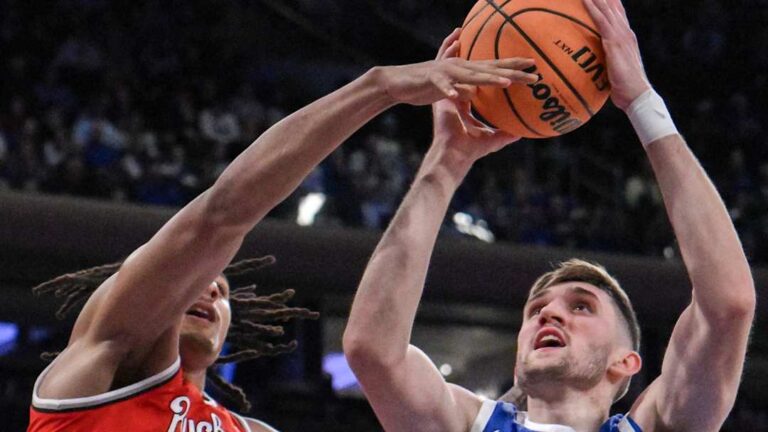Wildcats Collapse: Breaking Down Kentucky’s Shooting Nightmare Against Ohio State
Kentucky’s offense hit rock bottom in their clash against Ohio State, with the Wildcats delivering a catastrophic shooting performance that underscored significant weaknesses in their offensive execution. Shooting just 29% from the field and making only 17 shots in a full 40 minutes, the Wildcats left fans frustrated and coaches scratching their heads. Even their defense, which has bailed them out in the past, fell apart against a disciplined and efficient Buckeyes squad.
The lone silver lining in an otherwise dismal outing was Kentucky’s near-flawless performance at the free-throw line, where they converted 27-of-32 attempts. Those free throws accounted for 41.5% of their total points, a stat that not only highlights their reliance on drawing fouls but also emphasizes how poorly they executed in live play. Without those points, the final score could have been far more lopsided, bordering on historic humiliation.
Team-Wide Shooting Struggles
Kentucky’s shooting woes weren’t confined to one or two players—it was a collective failure. Among the starting lineup, no player managed to shoot above 33% from the field except for Brandon Garrison, who attempted just two shots, making one. Andrew Carr, Otega Oweh, and Jaxson Robinson combined for a lackluster 10-of-33 performance, with Carr and Robinson missing crucial layups in key moments. The bench, often counted on to provide a spark, offered little relief, contributing to the team’s offensive stagnation.
Beyond their overall field goal percentage, Kentucky’s three-point shooting was particularly disastrous. The Wildcats hit only 4-of-22 attempts (18.2%) from beyond the arc, failing to capitalize on open looks and settling for contested shots that played into Ohio State’s defensive scheme. Even inside the paint, where Kentucky has often excelled, they couldn’t find their rhythm. A slew of missed layups, rushed floaters, and untimely turnovers highlighted their inability to generate consistent scoring opportunities.
Ohio State’s Efficiency Highlights Kentucky’s Flaws
In stark contrast, Ohio State put on a clinic in offensive efficiency. The Buckeyes shot an impressive 56.6% from the field, sinking 30-of-53 attempts and nearly doubling Kentucky’s total field goals. They dominated inside, outscoring the Wildcats 36-24 in the paint while converting on high-percentage looks created through crisp ball movement and smart decision-making.
While Kentucky labored for every point, Ohio State consistently capitalized on open looks and second-chance opportunities. Their ability to finish through contact and maintain composure under pressure highlighted the stark difference between the two teams.
Free Throws: Kentucky’s Only Saving Grace
The Wildcats’ performance at the free-throw line was the only element of their game that stood out in a positive light. Shooting 27-of-32 (84.4%), Kentucky managed to stay somewhat competitive for stretches of the game. Otega Oweh, in particular, was perfect from the stripe, going 13-for-13. However, relying so heavily on free throws underscored the team’s inability to create offense through traditional means.
A Bigger Concern Moving Forward
This loss doesn’t just hurt because of the margin—it raises red flags about Kentucky’s ability to perform against quality opponents. Their inability to execute offensively in high-stakes games has become a troubling trend. Against Ohio State, their pace-and-space attack, typically one of the team’s strengths, looked disjointed and ineffective. Players forced shots, failed to rotate effectively on defense, and lacked the cohesion necessary to overcome adversity.
Ohio State’s defensive strategy exposed Kentucky’s lack of offensive versatility. Without consistent outside shooting or reliable finishes in the paint, the Wildcats became predictable, allowing the Buckeyes to dictate the tempo.
What Needs to Change
For Kentucky to remain competitive in the SEC and beyond, significant changes must occur. Improved ball movement, better shot selection, and a commitment to finishing plays in the paint are non-negotiables. Additionally, the Wildcats need more from their bench to provide depth and energy when their starters falter.
Perhaps most critically, Kentucky must regain its confidence in high-pressure situations. The Wildcats’ struggles in big games cannot continue if they hope to contend for conference or national titles. This loss should serve as a wake-up call, forcing the team to address its flaws and recalibrate its approach before heading into the heart of the season.
Ultimately, Kentucky’s performance against Ohio State was a humbling experience—a stark reminder that talent alone won’t carry them through tough matchups. Without significant improvements, their road ahead will only grow more challenging.
